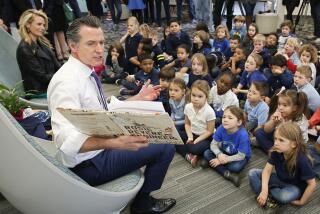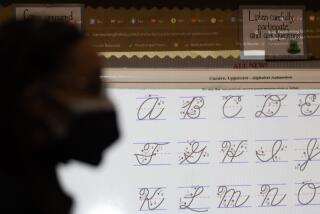A Bookish Debate : Phonics or Whole Language? Some Say Both Are Needed
VAN NUYS â Pam Corey snaked through the desks in her fifth-grade classroom at Van Nuys Elementary School on Wednesday, helping one child pronounce a word from âTikki Tikki Temboâ and guiding another through Dr. Seussâ âGreen Eggs and Ham.â
Every student sat with a different open book, reading or writing in their journals. Some laughed out loud. Others read out loud.
It was business as usual in Coreyâs reading and writing workshop.
Sitting in that cool Van Nuys classroom, these boys and girls, who learned to read mostly through the so-called âwhole languageâ approach, were clearly excited about reading. They had selected their own books, they liked their choices and they proudly kept logs showing the numbers of pages they had read.
But to hear a state education task force tell it, Coreyâs class is the exception rather than the rule. The whole language approach, it says, has created thousands of poor readers.
The task force report, released Wednesday, recommends that teachers use phonics, spelling and other basic reading skills. The phonics-versus-whole language debate has split language specialists into two camps.
Coreyâs answer: a little bit of both techniques.
Corey, a veteran Los Angeles Unified schoolteacher, already uses a combination of phonics and spelling along with the whole language approach of reading literature rather than standard primers. She said the whole idea of returning to see-Spot-run readers is outdated and unnecessary.
âI think itâll put us back,â Corey said. âWeâre educating children for the 21st Century. The old methods arenât the best anymore. We want people in our work force who think for themselves, who can adapt to new situations. I think weâll end up with bored kids.â
The whole language approach, embraced by Corey, teaches children to recognize words, as opposed to always sounding them out--in literature--and to analyze concepts. Many schools teach reading throughout the day--in English, social studies, even math--so students are constantly immersed in language and words.
Unknowingly, Maria Muratalla, 10, used a combination of phonics (to pronounce the words) and whole language (reading from a storybook) as she laughed her way through âTikki Tikki Tembo.â
âI try to pronounce them and if I donât figure it out, I ask my mom or my teacher,â she explained. âYou learn a lot of interesting things in books.â
Her classmate, Nancy Campoverde, 11, didnât trip over a word in âRose Petal Place,â but she explained how she figures out complicated words.
âI keep reading and I think what could it be and then I figure it out,â she said. âIf I canât, I ask my neighbor or tell the teacher.â
Across the room, Adelso Aguilar read Dr. Seuss quietly to himself. He explained that he was reading C.S. Lewisâ âThe Lion, the Witch and the Wardrobeâ in Spanish but was just beginning to get a grip on reading in English.
âI chose this one,â he said, pointing to Dr. Seuss, âbecause itâs easy and I want to learn more English.â
Sally Shane, principal at Van Nuys Elementary, said schools and teachers never should have abandoned basic skills and phonics--even when the whole language approach took hold in the late 1980s.
âIt should never have been stopped,â she said. âWe need a balance. There are many benefits of whole language. It exposes children to a variety of literature . . . that hooks them in.â
Added Corey: âChildren need to know that reading class is not just a reader and some basic questions. They need the idea that education and learning happens all the time--not just when they walk through that door.â
But the state task force, created last spring by state Supt. of Public Instruction Delaine Eastin in response to poor reading scores, found that students need to learn the basics--before they can be exposed to literature.
The task force also recommends that all students be reading independently no later than the end of the third grade.
Still, Corey and Shane say students need to be excited about reading--whether that means Dr. Seuss or C.S. Lewis. Perhaps the answer is found in just what Coreyâs students were already doing--a smattering of phonics (so kids can say the words) and a little bit of literature (so kids can actually enjoy those words too).
âThe wise teacher is the one who puts it all together,â Corey said. âThe one who uses phonics and symbols . . . and reads and talks about it. You donât do it by taking a reading book and assigning chapters and then asking a few questions.
âYou have to relate and interact,â she said.
* ACTION PLEDGED: State schools chief promises to move quickly on reading reform. A3
More to Read
Sign up for Essential California
The most important California stories and recommendations in your inbox every morning.
You may occasionally receive promotional content from the Los Angeles Times.










